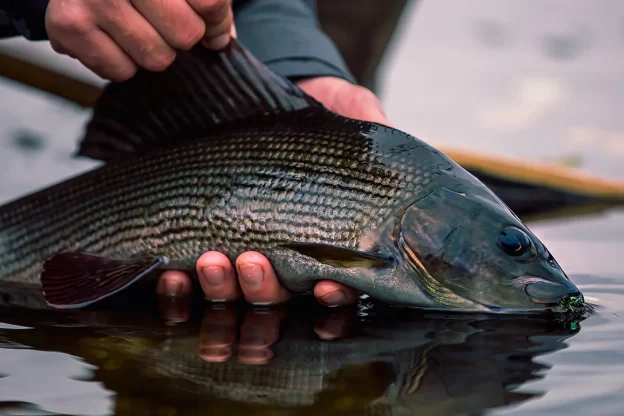Mackerel is tasty, lives in large groups and reproduces well. This makes it possible to catch huge quantities every year without harming the population: unlike many other species of fish that suffer from commercial fishing. We often eat mackerel, but what do we know about this fish? In this article you will learn many interesting details about the life of mackerel.
What does mackerel look like?
The average length of this fish is 30-40 cm, maximum 58-63 cm. Average weight 1-1.5 kg. The body of the mackerel is elongated, the snout is pointed. It is easily recognized by the characteristic dark stripes on the back, despite the absence of any on the belly. The back of the mackerel is dark blue with a steel sheen, while the sides and belly are silver with a yellowish tint. This makes it difficult for birds to see the mackerel when it comes to the surface because the color blends in with the water.
Mackerel has well-developed fins, it has additional ones that allow it to swim faster and maneuver better. Combined with their sleek bodies and well-developed muscles, this allows them to swim at speeds greater than other species can achieve. Mackerel can develop up to 80 km/h. speed.
Mackerel can reach this speed in just two seconds, which is equivalent to the acceleration of the fastest cars, but can only maintain it for a few seconds. Mackerel of all species usually swim at 20-30 km/h, which is how they swim most of the day - but they need a lot of food to do so.

What are the types of mackerel?
All types of mackerel are the same color with characteristic stripes on the back, but there are 4 types of this fish:
- Japanese mackerel, the smallest representative of the mackerel: the largest recorded weight - 550 g, body length - 44 cm
- African mackerel, whose mass is the largest representative of its species, it can weigh up to 1.6 kg and reach a length of 63 cm
- Atlantic mackerel. It is distinguished by the absence of a swim bladder, which is characteristic of other mackerel species. It is believed that it lost its importance due to the peculiarities of life in the sea, where it is necessary to quickly dive to a great depth and return to the surface during hunting. Atlantic mackerel have the most developed muscles that contract at a high frequency and allow the fish to be at the required depth in a horizontal position
- Australian mackerel. The meat is slightly different from other species: a little less fatty and tougher, so this type of mackerel is less popular, although it is caught in large quantities.
Where does the mackerel live?
Atlantic mackerel is found in the North Atlantic as well as in the Mediterranean Sea. In the warm season, it can reach the White Sea, and it is mostly found in the North Sea.
African mackerel also live in the Atlantic Ocean, but further south their ranges overlap, starting in the Bay of Biscay. It can also be found in the Canary Islands and the southern part of the Black Sea. They are most common in the Mediterranean Sea, especially in its southern part. Juveniles are found as far as the Congo, but adults swim north.
Japanese mackerel lives off the east coast of Asia and around Japan, in the Indonesian islands, and can be found as far east as Hawaii;
Australian mackerel is found off the coast of Australia, as well as in New Guinea, the Philippines, Hainan and Taiwan, Japan, and is distributed as far north as the Kuril Islands.
Mackerel lives mainly in waters of medium temperature. Mackerel are seasonal migratory fish, they move to places where the water temperature is optimal (10-18 °C).
Only fish living in the Indian Ocean practically do not migrate: there the water temperature does not change much throughout the year. Some populations migrate quite long distances, for example, Black Sea mackerel swim to the North Atlantic in winter, where warm currents keep the water in an optimal range. When spring comes, she goes back.

What does mackerel eat?
Although the mackerel is quite large, it mainly feeds on plankton: it filters the water and eats various small crustaceans in it. It also feeds on small crabs, larvae, insects and similar small animals.
However, it can also hunt various types of small fish. It mostly feeds on young herring or sprats. Such a menu is more characteristic of adult fish, and they can attack even very large prey in groups.
Mackerel fry often eat their relatives. Although cannibalism is also characteristic of adults. Larger fish often eat the young. All mackerel have a good appetite.
How mackerel reproduce
Spawns from the second year of life, then does it every year. The oldest mackerel, aged 10 to 15 years, spawn first, and in the Atlantic population this occurs in April. Then gradually younger and younger individuals start spawning, and so on until the last weeks of June, when 1-2 year old fish spawn.
Due to annual reproduction and the large amount of eggs laid at one time (about 500,000 eggs per individual), mackerel breed very quickly and even in the face of many threats and industrial fishing, they are very abundant. Spawning fish goes to warm waters near the shore, but at the same time chooses a place deeper and lays eggs at a depth of 150-200 m. This prevents many egg eaters, including other fish that don't swim that deep.
The eggs are small, about a millimeter in diameter, but each one contains, in addition to the embryo, a drop of fat that it can initially feed on. Spawned mackerel swim away, but the eggs have to lie for 10-20 days to form a larva. The exact period depends on water parameters and temperature, so mackerel try to choose a warmer place for spawning.
The newly born larva is unprotected from predators and is itself very aggressive. She attacks anything that is smaller and seems weaker than herself. She also eats her own kind. The hatched larva is only 3 mm long, but it begins to grow very quickly as it actively feeds. Since there is not enough food for all, most of them die during this period, but the rest grow up to 4-5 cm by autumn - however, they remain quite small and unprotected.
Mackerel in cooking
This oily fish is rich in omega-3. These good fats lower blood pressure and cholesterol levels in the body. Studies show that eating mackerel can reduce the risk of mental health problems and fight depression, bipolar disorder and autism due to the fatty acids it contains.
The vitamin D found in mackerel helps maintain the metabolism of phosphorus and calcium, two minerals essential for bone growth. Getting enough vitamin D reduces the risk of bone loss and fractures. This vitamin is supported by copper and selenium, which are essential for maintaining bone density.
Mackerel will also help you lose weight. It is rich in healthy fats and proteins, which are helpful in reducing the levels of ghrelin, the hunger hormone. Since mackerel is a high-protein food, it will keep you feeling full for longer, which will prevent you from overeating.
Fresh mackerel has an acidic pH level after digestion and is an allergen. Salted and smoked fish are not recommended for people with chronic diseases of the digestive tract, liver and kidneys.
Mackerel can be fried, boiled, grilled, pan-fried and of course smoked and salted. Baking in the oven takes about 20-30 minutes depending on the size of the fish. The mackerel fillet is soft but quite dense. It keeps its shape well even when cooking on high heat. Because Mackerel is an ideal fish to fry on the grill. If you like a spicy taste, cook mackerel with aromatic spicy ingredients (garlic, coriander, chili and lemongrass) Asian style.





